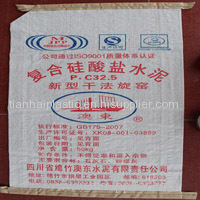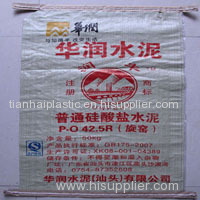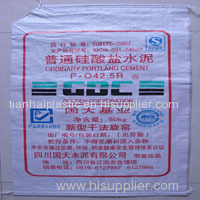|
Guilin Tianhai Plastic Co.,Ltd
|
sell Mongolia Darchan cement pp woven bag
| Payment Terms: | T/T,L/C |
| Place of Origin: | Guangxi, China (Mainland) |
|
|
|
| Add to My Favorites | |
| HiSupplier Escrow |
Product Detail
Mongolia Darchan cement pp woven bag
Tianhai Plastic Co. is experienced in woven PP cement bags for 10 years, establishing good cooperation relationship with big companies. Our product is of high quality and pretty competitive price.
Advantages of our product:
Flexible and of high strength,
Resistant to chemicals (alkali and acid resistant),
Corrosion resistant
Resistant to fungal growth
Moisture resistant - virtually unaffected by water and atmospheric moisture, doesn't absorb water
Lightweight
100% recyclable
Laminated Polypropylene Cement bag
| Raw Material | 100% new pp or as the customers' requirement |
| Color | White,Yellow as the customers' requirement |
| Printing | Offset printing |
| Width | As the customer's requirement |
| Length | As the customer's requirement |
| Weights/m2 | As the customer's requirement |
| Top | Heat cut or hemmed |
| Bottom | Single/double folded, single/double stitch |
| Lamination | Yes |
| Packing | 400 per bundle, can be customized |
| Minium Order | 300,000 |
| Lead Time | 15 days after place an order |
| Payment Term | L/C, T/T |
| Comparison of different material cement bag | ||||
| kraft paper bag | laminated polyproprpene woven bag | |||
| 1 | moisture-proof | Strong moisture absorption,water permeates layer by layer,deformation after wetting,high requirement for stacking | Isolated from moisture erosion in normal temperature,water absorption below 0.01% in 24 hours,low moisture permeability | |
| 2 | Environmental Protection | 24 trees was logged for making 1 ton of paper 8-20 tons of water was consumed for 1 ton of paper with subsequent severe water pollution | Byproduct of crude oil refining 100% recyclable few water demand in manufacture,maily recycling water | |
| 3 | cost | 1. manufacture: large water consumption 2. wastewater handling:should be processed by special apparatus,increasing expenditure and energy consumption 3. logistics:nearly twice heavier than laminated woven bag, uneconomical cost in transportation 4. recycling:same procee with manufacture with large water consumption,high resources cost and heavy pollution,increase wastewater handling cost.recycling less than 5.procurement cost:higher unit price than laminated woven bag | 1.manufacture:few water consumption,bare pollutant 2.logistics:nearly twice lighter than kraft paper bag,cost-effectiveness in transportation 3.recycling:recycling used bags for direct re-use,recycling more than 6 times,energy-saving to the maximum 4.procurement cost:relatively lower unit price than kraft paper bag | |
| 4 | strength | easily to be broken while drop test or unloading if the paper sizes are not uniform through multiple layer | high elongation and strength of weft and warp | |
| 5 | Tear and wear resistance | high friction between bags in stacking | with only about 0.12 rub coefficient between pp woven bags,convenient for unloading | |
| 6 | resycling | could be recycled about 3 times,functionality decreases with increasing recyling times recycling rate is 21% | simple recycling process,energy-saving,recycling more than 6 times no limites for recycling times,few influence in functionality high recycling rate | |
| conclusion: | To sum up,laminated PP woven bas has huge advantages in comprehensive use. 1 For functionality, it is of high strength and elongation and low rate of broken bags 2 For cost control,it is of low energy consumption and low recycling cost,besides in logistics expenditure,it is cost-effective.With same amount,the weight of plastic woven bags is much lighter than kraftpaper bags.And the unit price of laminated woven bag is at less 10% lower than kraft paper bag. | |||
History of cement package from wooden casks to final Polypropylene woven bag.Because of PP cement bag's advantages; PP cement bag is the future trend in cement packaging.
Imported cement was packaged in wooden casks11, each containing 3 bushels12, about 4 to 4.25 cubic feet (about 170 kg net) depending upon the fineness of the cement. Cement produced in Australia was initially supplied in similar sized wooden casks (C&CA 1928). Later cement was supplied in jute bags of 125lb.(56.7 kg) (Penn 1977), as well as wooden casks and light gauge steel drums of 400 lbs gross (375 lb. net) for export (Commonwealth 1904). In 1906, steel drums,semi-circular in cross section and equal to half a normal drum,.were designed to supply remote area by camel transportation. The jute bags proved to be to dusty leading to a docker strike. Paper lined jute bags were developed which led to the present multi-walled paper bag. When cement in paper bags was introduced, it sold at 127 pounds gross and 125 pounds net per bag.
Polypropylene was first polymerized to a crystalline isotactic polymer by Giulio Natta as well as by the German chemist Karl Rehn in March 1954.[4] This pioneering discovery led to large-scale commercial production of isotactic polypropylene by the Italian firm Montecatini from 1957 onwards.[5] Syndiotactic polypropylene was also first synthesized by Natta and his coworkers.
In china, paper cement bag have the whole market before 80's. In 80's, PP woven bag is used in cement packaging, and be in a rapid development This bag has a defect. That is easy to be dusty. We improved the design. Final laminated polypropylene woven bag came. It is accepted by whole market. And Chinese government set a policy to forbid the pp woven bag without lamination in 90's.
Laminated pp woven bag is Durable and hard to break, Light Weight so can save the freight for transfer, Moisture / Water Resistant, not easy to take dust and Reusable. PP cement bag(http://www.tianhaiplastic.com/) is low cost and high price-quality ratio. The raw material is get from oil and it is environmental-friendly. So laminated pp woven bag is the first selection for cement packaging. It dominates the Chinese market.
History of plastic woven bag
In 1930s, H.Jaeque invented a new technology to make cut cellosilk and split-film fiber through his study of PVC. In 1950s, O.B.Rasmussen used extruded film and drawing machine, invented the fiber for weaving. And in 1965, uniaxial oriented filament was put into mass production in Europe to manufacture woven bags for industrial packaging.
Cement was initially packaged in wooden casks, later changed to jute bags, which proved to be dusty. Therefore paper bags were developed. Plastic woven bags were invented in 1950s, main components were polyethylene, polypropylene and their composites. Plastic woven bag was used in cement packaging in early 1980s. In the middle of 1980s, paper bags were in short supply; plastic woven bags gradually got prevailed and became the main trends for cement packaging. Plastic woven bag is in constant improvement to meet the increasing performance requirements met in practical use. During decades of development, laminated plastic woven bags are the most universal packaging material in cement industry in many countries, for example, plastics woven bags dominate the China market.
In china, paper cement bag have the whole market before 80's. In 80's, PP woven bag is used in cement packaging, and be in a rapid development This bag has a defect. That is easy to be dusty. We improved the design. Final laminated polypropylene woven bag came. It is accepted by whole market. And Chinese government set a policy to forbid the pp woven bag without lamination in 90's.
Laminated pp woven bag is Durable and hard to break, Light Weight so can save the freight for transfer, Moisture / Water Resistant, not easy to take dust and Reusable. PP cement bag is low cost and high price-quality ratio. The raw material is get from oil and it is environmental-friendly. Plastic woven bags have already displaced traditional cement packaging materials in many countries, and keep an optimistic growth globally in years. The demand for it would be increase according to estimated due to lots of construction projects and infrastructures are planned to be commenced in recent years.










